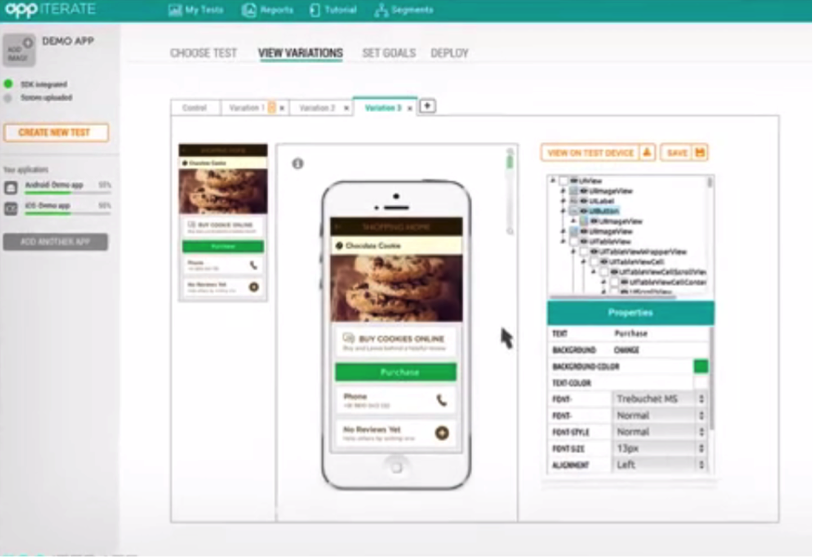 Product management and development teams have been using A/B Testing on the web to optimize the experience for users. However, doing A/B testing on mobile has been a challenge especially because the way native apps are deployed currently:
Product management and development teams have been using A/B Testing on the web to optimize the experience for users. However, doing A/B testing on mobile has been a challenge especially because the way native apps are deployed currently:
– Native apps are deployed via the marketplaces, making MVP and beta releases very difficult.
– The app stores, especially iTunes, has a review cycle which means apps are available download only after a period of time.
Therefore companies aren’t able to experiment as quickly or thoroughly as they are on the Web. Every app release is a gamble that relies on the assumption that every aspect of the release will appeal to the app’s audience. If it doesn’t, or if there’s a problem, filing an updated version of the app and having it reach the marketplace can take days or weeks.
Developers and product managers need to see how small changes affect engagement, retention, lifetimes value and, of course, monetization of their apps. AppIterate intends to solve this problem with their WYSIWYG A/B testing platform for native mobile apps. It allows app publishers to A/B test and iteratively optimize their designs/UX and functionality of their mobile apps to improve in app purchases, user engagement and conversion metrics. It also allows app publishers to run tests and deploy based on user segments and see real time conversion metrics.
Some of the main features of the app include Real Time A/B testing on native apps, using which developers can test new designs, copy, call-to-action buttons in real-time and push the winning version to all the users without pushing a new update to the app store. Feature Testing and Roll-back is another feature using which developers can test new Features, UX-flows etc during an app update process on a sample population. If the feature does well, deploy it to all of the users, otherwise roll-it back, all without pushing another update through the app store.
Many a times, small changes to the app are required, like a change in copy, change in phone number, increase/change in size/position of a button. The service also gives app-publishers, the ability to make these changes and push them to the users live without re-submitting the app to the app store. Segmentation lets you target a subset of your users based on the criteria defined by you. You can target users based on their OS version, activity, location or any other custom criteria defined by you. Thanks to WYSIWYG editor, even Marketers and Product Managers can create A/B tests easily without any knowledge of coding at all.
Mobile A/B Testing has seen a flurry of activities in the last few months. This includes startups with venture backing such as Apptimize, Swrve and Leanplum. Most of these allow publishers to do A/B testing on native apps using a web interface and get interesting analytics. Other rivals include Pathmapp and Bees & Pollen. There also players such as BetaGlide which can also measure CPU and memory consumption of an app while it is running and can track it against an event.
Appiterate: Instant publishing & A/B testing on mobile apps using visual editor for iOS and Android apps
AppIterate is a WYSIWYG A/B testing platform for native mobile apps. It allows app publishers to A/B test and iteratively optimize their designs/UX and functionality of their mobile apps to improve in app purchases, user engagement and conversion metrics. It also allows app publishers to run tests and deploy based on user segments and see real time conversion metrics.
On April 21st, Avinash and I had a telephonic chat with Tanuj Mendiratta on the story behind Appiterate, their current traction and future roadmap.
Q. Could you give our readers some background about Airwoot and how you started the venture.
[Appiterate]: Appiterate was founded by 3 cofounders who were each pursing different paths. Anuj and I started working on DSYN while I was still studying at IIM Calcultta. Anuj was my batchmate from DCE. We figured out the in the mobile space a lot of tech was happening but nothing much on design. DSYN was trying to fill this gap. By December 2010, we had signed up a few clients including the likes of Vodafone. We both, then decided to skip the placements. We soon got in touch with Mayank, an IITD grad, who was working on tech offerings in the similar field. Given our complimentary offerings, we decided to partner together. We grew the services company to 35 people, with more than INR 2 Cr annual revenue and signed up clients such as Zomato, Ixigo, Sears, P&G etc.
Q. How and when did you decide to pivot from a services company to a product company?
[Appiterate]: Our services business was growing pretty well. But we wanted to scale quickly and build a big company. A lot of interesting things were happening on mobile, and with age at our side, we wanted to experiment with something that could grow big quite fast. We also felt that running product and services together was impossible as it meant compromising on the services delivery.
We started working on a product in January 2013. By middle of last year, we raised funding from SAIF and by October we closed down the services business completely.
Q. What happened once you decided to close down your services business?
[Appiterate]: Once we decided to pivot, we felt the need to hire a completely new team as working on a product meant different skill sets and approach. However, we worked with every employee to ensure that they were able to transition to positions at other companies. This included working with our clients to absorb some of engineers as well as conducting interviews at our office for our employees.
Q. Was the decision to close down services business completely triggered by having investors on board?
[Appiterate]: No, it was a completely internal decision. We wanted to purely focus on product.
Q. Was the decision to close down services business completely triggered by having investors on board?
[Appiterate]: No, it was a completely internal decision. We wanted to purely focus on product.
Q. How did you identify the product that you wanted to focus on?
[Appiterate]: During our services business, we interacted with a lot of clients to figure out what they were looking and whether we could productize any of these. We figured out that there was no platform in the market that allowed companies to interact and manage relationships with their users for their mobile apps. Hence we narrowed down to Appiterate.
Q. In terms of your approach and mindset, what did it mean to pivot to a product company?
[Appiterate]: There is a mindset challenge that you need to overcome when pivot to a complete product based company. With services, revenue was coming in steadily and we were a decently established profitable company. From this we moved to a company with no customers and start building out a new product from scratch.
Q. There are a couple of other A/B testing platforms that have come up, so of the backed by accelerators such as YC and TechStars. How do you see them?
[Appiterate]: There are a couple of startups that have come up in the silicon valley offering an A/B testing platform for mobile. This is a good validation for us about the market opportunity. However in terms of product, we believe we are more refined than the other players.
Q. Which is your current focused market?
[Appiterate]: We are focused on the global market. At the same, the Indian ecosystem has also matured, and we are seeing traction here as well.
Q. Given that you do not have presence elsewhere, how are you tapping the global market?
[Appiterate]: In today’s globalized world, location does not matter. We travel to meet our potential customers, organize webinars etc. to get in touch with and explain our offerings.
Q. Tell us something about your current team
[Appiterate]: Our current team strength is 10 and that includes some brilliant folks.
Q. What is Appiterate’s business model?
[Appiterate]: We are offering our platform on a SaaS model.
Q. What does Appiterate’s roadmap look like?
[Appiterate]: A/B Testing is just the start for us. We want to help app publishers better monetize post download. We want to be a CRM for mobile apps wherein a product manager can manage all communication with the users.
Q. What is your marketing strategy?
[Appiterate]: We intend to use both inbound and outbound marketing and position ourselves as a complete relationship management platform for mobile apps.



